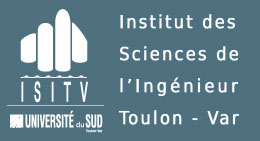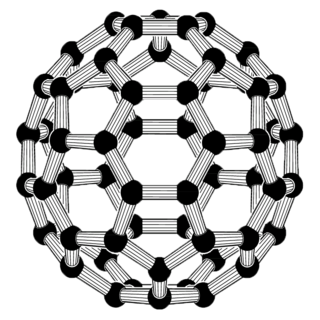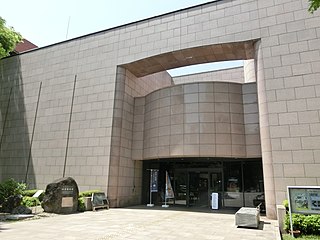
A humanoid robot is a robot resembling the human body in shape. The design may be for functional purposes, such as interacting with human tools and environments, for experimental purposes, such as the study of bipedal locomotion, or for other purposes. In general, humanoid robots have a torso, a head, two arms, and two legs, though some humanoid robots may replicate only part of the body. Androids are humanoid robots built to aesthetically resemble humans.

Sumio Iijima is a Japanese physicist and inventor, often cited as the inventor of carbon nanotubes. Although carbon nanotubes had been observed prior to his "invention", Iijima's 1991 paper generated unprecedented interest in the carbon nanostructures and has since fueled intense research in the area of nanotechnology.
Riken is a national scientific research institute in Japan. Founded in 1917, it now has about 3,000 scientists on seven campuses across Japan, including the main site at Wakō, Saitama Prefecture, on the outskirts of Tokyo. Riken is a Designated National Research and Development Institute, and was formerly an Independent Administrative Institution.

The Korea Institute of Science and Technology is a multi-disciplinary research institute located in Seoul, South Korea. Founded in 1966, it was the first multi-disciplinary scientific research institute in Korea and has contributed significantly to the economic development of the country, particularly during the years of accelerated growth in the 1970s and 1980s. It has a research staff of over 1,800 research scientists, visiting scientists, fellows and trainees, and foreign scientists involved in basic research in various fields of science and technology.
Kwangwoon University is a comprehensive and private research university in Nowon-gu, Seoul, South Korea, offering undergraduate and graduate programs. Chosun Radio Training Center, the predecessor of Kwangwoon University, was the first institution to teach electronic engineering studies in Korea. The foundation is Kwangwoon Academy, an incorporated educational institution. As of 2019, there are 11,500 undergraduates and 1,292 graduate students.

In Japan, popular robots include humanoid entertainment robots, androids, animal robots, social robots, guard robots, and many more. Each type has a variety of characteristics.
Robotics is the branch of technology that deals with the design, construction, operation, structural disposition, manufacture and application of robots. Robotics is related to the sciences of electronics, engineering, mechanics, and software. The word "robot" was introduced to the public by Czech writer Karel Čapek in his play R.U.R., published in 1920. The term "robotics" was coined by Isaac Asimov in his 1941 science fiction short-story "Liar!"
The Humanoid Robotics Project (HRP) is a project for development of general domestic helper robots, sponsored by Japan's Ministry of Economy, Trade and Industry (METI) and New Energy and Industrial Technology Development Organization (NEDO), spearheaded by Kawada Industries and supported by the National Institute of Advanced Industrial Science and Technology (AIST) and Kawasaki Heavy Industries, Inc. The HRP series also goes by the name Promet. The HRP should not be confused with the HOAP series, which is manufactured by Fujitsu.

Hiroaki Kitano is a Japanese scientist. He is the head of the Systems Biology Institute (SBI); Senior Executive Vice President and Chief Technology Officer of Sony Group Corporation, Chief Executive Officer of Sony Research Inc. and Sony Computer Science Laboratories, Inc.; a Group Director of the Laboratory for Disease Systems Modeling at and RIKEN Center for Integrative Medical Sciences; and a professor at Okinawa Institute of Science and Technology (OIST). Kitano is known for developing AIBO, and the robotic world cup tournament known as Robocup.

The Institut des Sciences de l'Ingénieur de Toulon et du Var, or ISITV, was a French public engineering school. It was located in the south of France, between Toulon and Hyères, on the French Riviera. In 2014, the school merged with Supméca to form a new engineering school called SeaTech.

Hiromichi Kataura is a Japanese scientist known for his work on synthesis and characterization of single-wall and double-wall carbon nanotubes and on encapsulation of water, fullerenes and other organic molecules into carbon nanotubes.

The optical properties of carbon nanotubes are highly relevant for materials science. The way those materials interact with electromagnetic radiation is unique in many respects, as evidenced by their peculiar absorption, photoluminescence (fluorescence), and Raman spectra.
The Spectral Database for Organic Compounds (SDBS) is a free online searchable database hosted by the National Institute of Advanced Industrial Science and Technology (AIST) in Japan, that contains spectral data for ca 34,000 organic molecules. The database is available in English and in Japanese and it includes six types of spectra: laser Raman spectra, electron ionization mass spectra (EI-MS), Fourier-transform infrared (FT-IR) spectra, 1H nuclear magnetic resonance (1H-NMR) spectra, 13C nuclear magnetic resonance (13C-NMR) spectra and electron paramagnetic resonance (EPR) spectra. The construction of the database started in 1982. Most of the spectra were acquired and recorded in AIST and some of the collections are still being updated. Since 1997, the database can be accessed free of charge, but its use requires agreeing to a disclaimer; the total accumulated number of times accessed reached 550 million by the end of January, 2015.

The HRP-4C, nicknamed Miim, is a feminine-looking humanoid robot created by the National Institute of Advanced Industrial Science and Technology (AIST), a Japanese research facility.

RT-middleware is a common computing platform technical standard for robots based on distributed object technology. RT-middleware supports the construction of various networked robotic systems by integrating various network-enabled robotic elements named RT-Components, which specification standard is discussed and defined by the Object Management Group (OMG).

OpenRTM-aist is a software platform developed on the basis of the RT middleware standard. OpenRTM-aist is developed by National Institute of Advanced Industrial Science and Technology which also contributes to definition of the RT-middleware standard.
The Regional Centre for Biotechnology (RCB) is an autonomous institution of education, training and research established under the auspices of United Nations Educational, Scientific and Cultural Organization (UNESCO) and Department of Biotechnology. The Parliament has passed the Regional Centre for Biotechnology Bill, 2016 to provide statutory status to the existing institution. Dr. Arvind Sahu is the executive director of RCB.
Masakatsu G. Fujie is a Japanese scientist who has played a major role in cutting-edge research in biomedical engineering. He has been responsible for many advances in the field of robotics.

The Geological Survey of Japan (GSJ) is a research institute and department of the National Institute of Advanced Industrial Science and Technology (AIST), an Independent Administrative Institution under the Ministry of Economy, Trade and Industry (METI). The Survey was initially formed in 1882 under the Ministry of Agriculture and Commerce. The Geological Survey of Japan conducts surveys of and publishes research into the geology of Japan, produces geological maps of Japan, and operates the Geological Museum.











